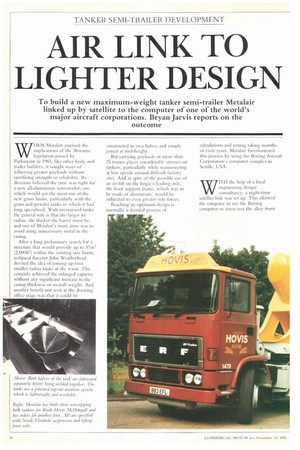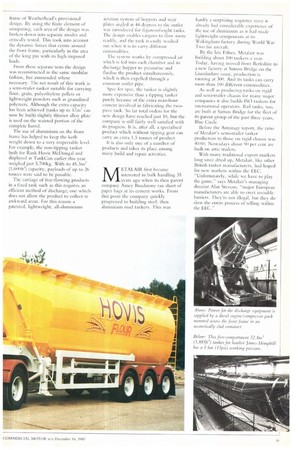AIR LINK TO LIGHTER DESIGN
Page 40

Page 41

If you've noticed an error in this article please click here to report it so we can fix it.
To build a new maximum-weight tanker semi-trailer Metalair linked up by satellite to the computer of one of the world's major aircraft corporations. Bryan Jarvis reports on the outcome
WHEN Metalair assessed the implications of the 38-tonne legislation passed by Parliament in 1983, like other body and trailer builders, it sought ways of achieving greater payloads without sacrificing strength or reliability. Its directors believed the time was right for a new all-aluminium semi-trailer; one which would get the most out of the new gross limits, particularly with the grain and powder tanks in which it had long specialised. With pressurised tanks the general rule is that the larger its radius, the thicker the barrel must he; and one of Metalair's main aims was to avoid using unnecessary metal in the casing.
After a long preliminary search for a structure that would provide up to 57m3 (2,00(lft-') within the existing size limits, technical director John Weatherhead devised the idea of joining up two smaller radius tanks at the waist. This certainly achieved the enlarged capacity without any significant increase in the casing thickness or overall weight. And another benefit not seen at the drawing office stage was that it could he
constructed in two halves and simply joined at mid-height.
But carrying payloads of more than 23 tonnes places considerable stresses on tankers, particularly while manoeuvring at low speeds around difficult factory sites. And in spite of the possible use of an air-lift on the bogie's leading axle, the front support frame, which was to be made of aluminium, would he subjected to even greater side forces.
Reaching an optimum design is normally a detailed process of calculations and testing taking nmnths or even years. Metalair foreshortened this process by using the Boeing Aircraft Corporation's computer complex in Seattle, USA.
WITII I the help of a local engineering design
consultancy, a night-time satellite link was set up. This allowed the company to use the Boeing computer to stress test the alloy front
frame of Weatherhead's provisional design. By using the finite element of computing, each area of the design was broken down into separate modes and critically tested. This took into account the dynamic forces that centre around the front frame, particularly in the area of the king pin with its high imposed loads.
From these separate tests the design was reconstructed in the sante modular fashion, but ammended where necessary. The net result of tins work is a semi-trailer tanker suitable for carrying flour, grain, polyethylene pellets or lightweight powders such as granulated polymers. Although the extra capacity has been achieved (tanks up to 57m1 can now be built) slightly thinner alloy plate is used on the waisted Portion of the complete barrel.
The use of aluminium on the front frame has helped to keep the kerb weight down to a very respectable level. For example, the non-tipping tanker built for Rank Hovis McDougal and displayed at TankCon earlier this year weighed just 5,700kg. With its 45.31113 (1,600ft3) capacity, payloads of up to 26 tonnes were said to be possible.
The carriage of free-flowing products in a fixed tank such as this requires an efficient method of discharge; one which does not allow the product to collect in awkward areas. For this reason a patented, lightweight, all-aluminium aeration system of hoppers and weir plates angled at 44 degrees to the outlet was introduced thr figure-of-eight tanks. The design enables cargoes to flow more readily, .ind the tank is easily washed out when it is to carry different commodities.
The system works by compressed air which is fed into each chamber and its discharge hopper to pressurise and fluidise the product simultaneously, which is then expelled through a common outlet pipe.
Spec tbr spec, the tanker is slightly more expensive than a tipping tanker purely because of the extra man-hour content involved in fabricating the twopiece tank. So far total orders for the new design have reached just In, hut the company is still fairly well satisfied with its progress. It is, after all, a specialised product which without tipping gear can carry an extra 1.5 tonnes of product.
It is also only one of a number of products and takes its place among many build and repair activities.
METALAIR first hecame interested in bulk handling 35 years ago when its then parent company Amey Roadstone ran short of paper bags at its cement works. From that point the company quickly progressed to building steel, then aluminium road tankers. This was
hardly a surprising sequence since it already had considerable experience of the use of aluoliniUm as it had made lightweight components at its Wokingham factory during World War Two for aircraft.
By the late Fifties, Metalair was building about 1110 tankers a year. Today, having moved from Berkshire to a new factory at Sutton Bridge on the Lincolnshire coast, production is running at 300. And its tanks can carry more than 100 different commodities.
As well as producing tanks on rigid and semi-trailer chassis for many major companies it also builds ISO tankers for international operators. Rail tanks, too, are built at Sutton Bridge for the fleet of its parent group of the past three years, Blue Circle.
Before the Armitage report, the ratio of Metalair's semi-trailer tanker production to those on rigid chassis was 40/60. Nowadays about 90 per cent are built on arric trailers.
With many traditional export markets long since dried up, Metalair, like other British tanker manufacturers, had hoped for new markets within the EEC. "Unfortunately, while we have to play the game," says Metalair's managing director Alan Stevens, "major European manufacturers are able to erect invisible barriers. They're not illegal, but they do slow the entire process of selling within the EEC."




































































































